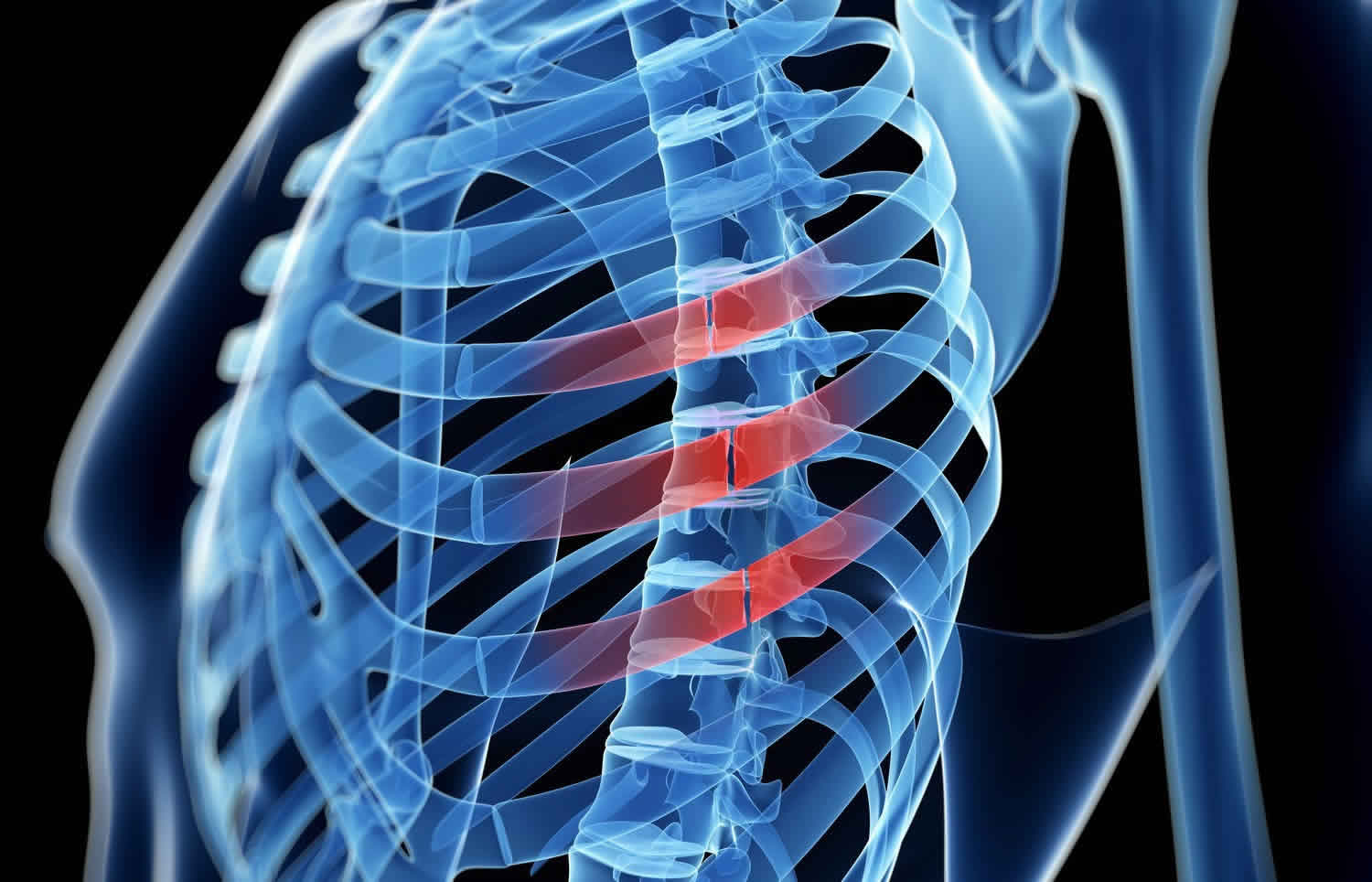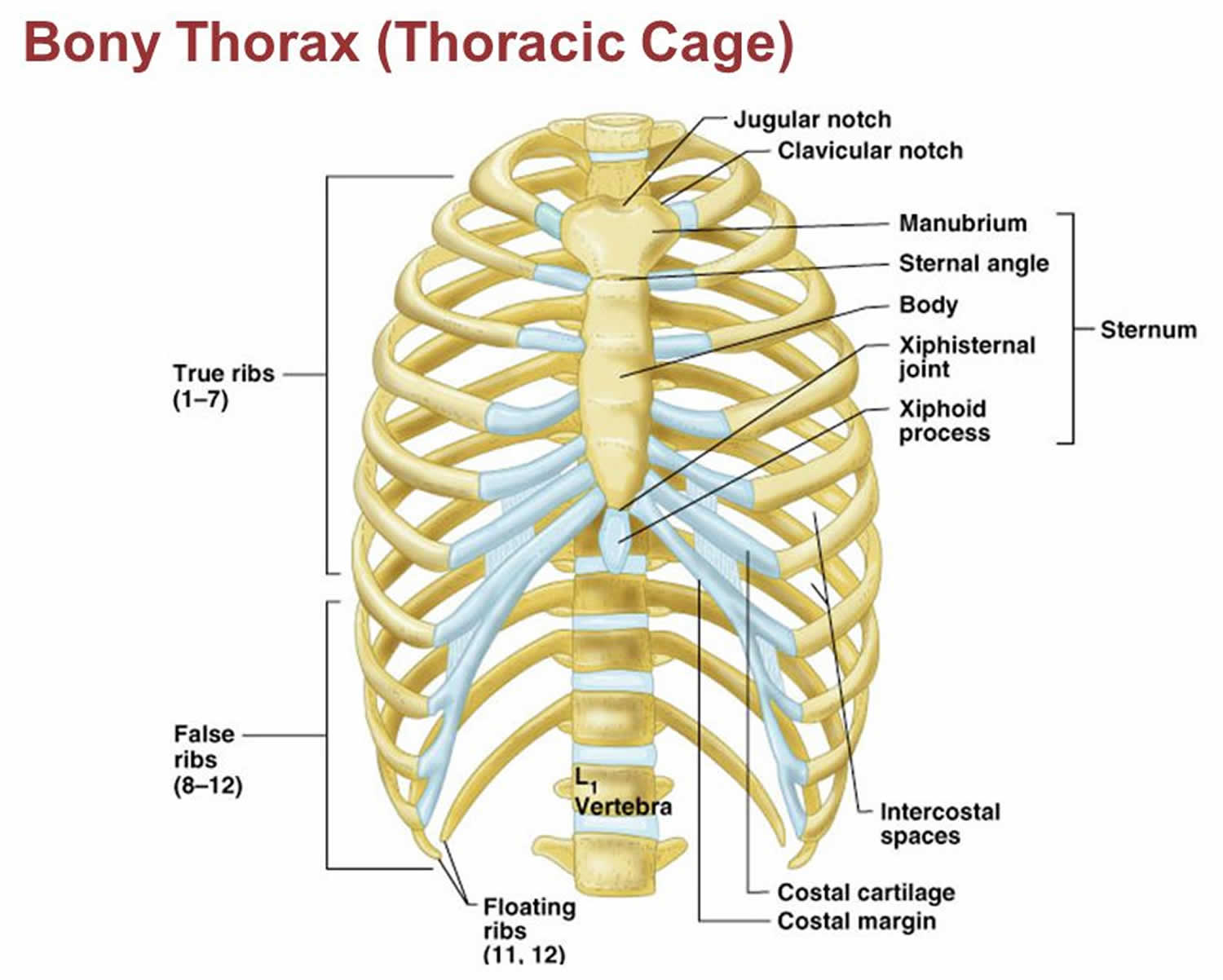Contents
Rib fracture
Rib fracture or a broken rib is a common injury that occurs when one of the bones in your rib cage breaks or cracks. A rib fracture can be very painful because your ribs move when you breathe, cough, and move your upper body. The ribs in the middle of the chest are the ones that break most often. The most common cause of rib fracture is chest trauma, such as from a fall, motor vehicle accident or impact during contact sports. Many rib fractures are merely cracked. While still painful, cracked ribs aren’t as potentially dangerous as ribs that have been broken into separate pieces. A jagged edge of broken bone can damage major blood vessels or internal organs, such as the lung. So, your doctor will also check to see if you have any other injuries.
In most cases, rib fractures usually heal on their own in one or two months. Rib fracture healing takes at least 6 weeks. Adequate pain control is important so that you can continue to breathe deeply and avoid lung complications, such as pneumonia.
See your doctor if you have a very tender spot in your rib area that occurs after trauma or if you have difficulty breathing or pain with deep breathing.
Seek medical attention immediately if you feel pressure, fullness or a squeezing pain in the center of your chest that lasts for more than a few minutes or pain that extends beyond your chest to your shoulder or arm. These symptoms can indicate a heart attack.
Call your doctor if you have:
- Pain that does not allow deep breathing or coughing despite using pain relievers
- Fever
- Cough or increase in mucus that you cough up
- Shortness of breath
- Side effects of pain medicine such as nausea, vomiting, or constipation, or allergic reactions, such as skin rashes, facial swelling, or difficulty breathing
People with asthma or emphysema are at increased risk of developing complications from a rib fracture, such as breathing problems or infections.
Figure 1. Rib cage
Rib fracture causes
Broken ribs are most commonly caused by direct impacts — such as those from motor vehicle accidents, falls, child abuse or contact sports. Ribs also can be fractured by repetitive trauma from sports like golf and rowing or from severe and prolonged coughing.
Risk factors for rib fracture
The following factors can increase your risk of breaking a rib:
- Osteoporosis. Having this disease in which your bones lose their density makes you more susceptible to a bone fracture.
- Sports participation. Playing contact sports, such as hockey or football, increases your risk of trauma to your chest.
- Cancerous lesion in a rib. A cancerous lesion can weaken the bone, making it more susceptible to breaks.
Rib fracture prevention
The following measures may help you prevent a rib fracture:
- Protect yourself from athletic injuries. Wear protective equipment when playing contact sports.
- Reduce the risk of household falls. Remove clutter from your floors and clean spills promptly, use a rubber mat in the shower, keep your home well-lit, and put skidproof backing on carpets and area rugs.
- Strengthen your bones. Getting enough calcium and vitamin D in your diet is important for maintaining strong bones. Aim for about 1,200 milligrams of calcium and 600 International Units (IU) of vitamin D daily from food and supplements.
Rib fracture symptoms
The pain associated with a rib fracture usually occurs or worsens when you:
- Take a deep breath
- Press on the injured area
- Bend or twist your body
Rib fracture complications
A rib fracture can injure blood vessels and internal organs. The risk increases with the number of broken ribs. Complications vary depending on which ribs break.
Rib fracture possible complications include:
- Torn or punctured aorta. A sharp end of a break in one of the first three ribs at the top of your rib cage could rupture your aorta or another major blood vessel.
- Punctured lung. The jagged end of a broken middle rib can puncture a lung and cause it to collapse.
- Lacerated spleen, liver or kidneys. The bottom two ribs rarely fracture because they have more flexibility than do the upper and middle ribs, which are anchored to the breastbone. But if you break a lower rib, the broken ends can cause serious damage to your spleen, liver or a kidney.
Rib fracture diagnosis
During the physical exam, your doctor will press gently on your ribs. He or she might also listen to your lungs and watch your rib cage move as you breathe.
Your doctor likely will order one or more of the following imaging tests:
- X-ray. Using low levels of radiation, X-rays make bones visible. But X-rays often have problems revealing fresh rib fractures, especially if the bone is merely cracked. X-rays are also useful in diagnosing a collapsed lung.
- CT scan. This often can uncover rib fractures that X-rays might miss. Injuries to soft tissues and blood vessels are also easier to see on CT scans. This technology takes X-rays from a variety of angles and combines them to depict cross-sectional slices of your body’s internal structures.
- MRI. This can be used to look at the soft tissues and organs around the ribs to determine if there’s damage. It can also help in the detection of more subtle rib fractures. An MRI uses a powerful magnet and radio waves to produce cross-sectional images.
- Bone scan. This technique is good for viewing stress fractures, where a bone is cracked after repetitive trauma — such as long bouts of coughing. During a bone scan, a small amount of radioactive material is injected into your bloodstream. It collects in the bones, particularly in places where a bone is healing, and is detected by a scanner.
Rib fracture treatment
If you injure other body organs, you may need to stay in the hospital. Otherwise, you can heal at home. Most people with broken ribs do not need surgery.
In the emergency room, you may have received a strong medicine (such as a nerve block or narcotics) if you were in severe pain.
You will not have a belt or a bandage around your chest because these would keep your ribs from moving when you breathe or cough. This may lead to a lung infection (pneumonia).
Pain Relief
It’s important to obtain adequate pain relief — if it hurts to breathe deeply, you may develop pneumonia. Apply an ice pack 20 minutes of every hour you are awake for the first 2 days, then 10 to 20 minutes 3 times daily as needed to reduce pain and swelling. Wrap the ice pack in a cloth before applying to the injured area.
You may need prescription pain medicines (narcotics) to keep your pain under control while your bones heal.
- Take these medicines on the schedule your doctor prescribed.
- DO NOT drink alcohol, drive, or operate heavy machinery while you are taking these medicines.
- To avoid becoming constipated, drink more fluids, eat high-fiber foods, and use stool softeners.
- To avoid nausea or vomiting, try taking your pain medicines with food.
If your pain is not severe, you can use ibuprofen (Advil, Motrin) or naproxen (Aleve, Naprosyn). You can buy these pain medicines at the store.
- These should be avoided for the first 24 hours after your injury since they may lead to bleeding.
- Talk with your doctor before using these medicines if you have heart disease, high blood pressure, kidney disease, liver disease, or have had stomach ulcers or internal bleeding in the past.
- DO NOT take more than the amount recommended on the bottle or by your provider.
Acetaminophen (Tylenol) may also be used for pain by most people.
If oral medications don’t help enough, your doctor might suggest injections of long-lasting anesthesia around the nerves that supply the ribs.
Tell your doctor about any other medicines you are taking as drug interactions may occur.
Therapy
Once your pain is under control, your doctor might prescribe breathing exercises to help you breathe more deeply because shallow breathing can put you at risk of developing pneumonia.
In the past, doctors would use compression wraps — elastic bandages that you can wrap around your chest — to help splint and immobilize the area. Compression wraps aren’t recommended for broken ribs anymore because they can keep you from breathing deeply, which can increase the risk of pneumonia.
Activity
To help prevent a collapsed lung or lung infection, do slow deep-breathing and gentle coughing exercises every 2 hours. Holding a pillow or blanket against your injured rib can make these less painful. You may need to take your pain medicine first. Your doctor may tell you to use a device called a spirometer to help with the breathing exercises. These exercises help prevent a partial lung collapse and pneumonia.
It is important to stay active. DO NOT rest in bed all day. Your doctor will talk with you about when you can return to:
- Your everyday activities
- Work, which will depend on the type of job you have
- Sports or other high impact activity
While you heal, avoid movements that put painful pressure on your ribs. These include doing crunches and pushing, pulling, or lifting heavy objects.
Follow-up
Your doctor will make sure you are doing your exercises and that your pain is under control so that you can be active.
There is usually no need for taking x-rays as you heal, unless you develop fever, cough, increasing pain or difficulty breathing.
Rib fracture healing time
Most rib fractures heal on their own within six weeks. Restricting activities and icing the area regularly can help with healing and pain relief.






